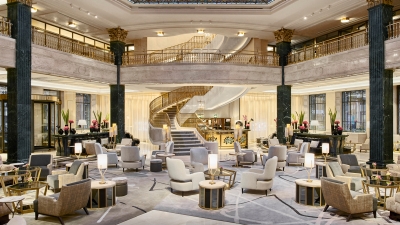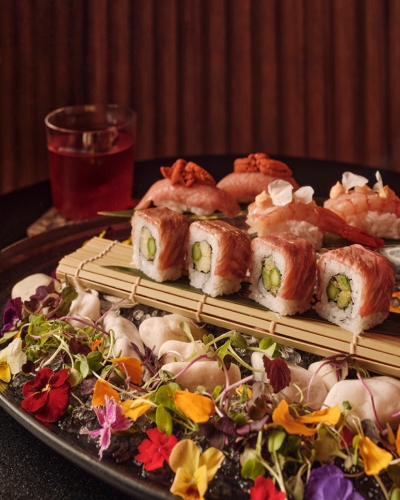There’s no other place in Spain that screams Madrid like the rooftop of Four Seasons Hotel Madrid. The crossroads of the three iconic streets – Canalejas, Sevilla and Alcalá - has been featured in countless novels by Spanish writers such as Perez-Galdós. The area housed the country’s first guest houses and luxury hotels, such as the famous La Fontana de Oro. Some were bombed and rebuilt after the war and others were the venues for patriotic gatherings under king Fernando VII.
This unbeatable location is not only the historical and beating heart of the city, but also the physical centre of the country, the kilometre zero of the Spanish road network.
Never before in Madrid had the transformation of seven such historic buildings been undertaken simultaneously, ensuring a common identity while preserving their independent styles dating back to the late 1800s, the most prominent being La Equitativa, a former American insurance house located in the "bow” of this triangle-shaped block. Later, in 1920 this building became one of Spain’s most important banks, Banco Español de Crédito.
During the transformation project, more than 16,000 pieces were extracted, catalogued and painstakingly restored, with around 3,700 being brought back into the building. Many can now be found in the suites and public areas of the Hotel, such as the impressive green marble pillars with gilded capitals in the Hotel lobby that was once the main bank’s hall.
Four Seasons Hotel Madrid is completed by the Hotel’s 22 Private Residences and Galeria Canalejas, the three-level luxury shopping mall set to become the place to shop for well-heeled madrileños and international visitors. The character of the Hotel reflects the character of the locals themselves - unpretentious, approachable, friendly and fun loving.
Estudio Lamela developed the incredibly challenging architecture project, while the interior design was by BAMO in San Francisco. Isa gastrobar on the first floor, named after one of Spain’s most notorious queens, was designed by AvroKo, and Marbella-born celebrity Chef Dani Garcia’s Dani brasserie by Martin Brudnizki's studio in London.
The spectacular art collection around the Hotel features more than 2,000 pieces of art all by Spanish artists, such as the Starry Night installation by Eduardo Pérez-Cabrero in the lobby's staircase formed by star constellations representing human virtues of intelligence, creativity, joy, love, talent, generosity and hope, or the plaster carvings in the rooms done in collaboration with the Royal Academy of Fine Arts of San Fernando located opposite the Hotel.
The interior colour palette consists of copper shades, graphite blue, saffron, and pearly whites and the walls of the striking Sol Ballroom are covered in a bold terracotta red inspired by Madrid’s rooftops.
The striking Royal Suite’s living room was the private office of the bank's presidents and board members since the early 1900s, and has retained most of its original features, including the fireplace, the ceiling's molding and original Juliet balconies while introducing a sculptural round bathtub backed by a wall of Calacatta Vagli Rosato marble and specially sourced onyx Viola.
A “social suite” is what the designers had in mind when designing the Presidential Suite, with spectacular views over the city’s rooftops, the Casino de Madrid and the sculpture of the chariot that culminates the imposing building on the other side of Calle Alcalá.
The 200 spacious guest rooms, some with outdoor terraces, are decorated with two-tone accents: pale blue or yellow. The bathrooms are clad in white and grey marble combined with dramatic chocolate brown.
Due to the enormous complexity of gracefully joining together seven different buildings, the Hotel offers 118 types of guest rooms; give of them are double height loft rooms with double ceilings that provide a very dynamic and unusual space in a Hotel.
The Hotel’s Spa is the largest in Madrid. Filled with natural light, the concept revolves around the three three elements of nutrition, renewal and reflection. The show stopper - and place-to-be - during Madrid’ balmy days is the rooftop swimming pool. Its terrace allows guests to marvel at the views stretching over to the city’s skyline.
Interesting Facts
- The building was completely hollowed out except the façade and the initial structure. All the historic elements - columns, bank safety boxes, doors, and more - were removed and taken into a warehouse where they were restored.
- 7,800 square metres (84,000 square feet) of façade have been restored
- The elephant heads on the main building’s façade originated from the building's architect José Grases' interest in theatres, especially the Parisian Eden-Theater where the same animal heads are present. He used them again in the Teatro Lírico de Madrid.
- The two human sculptures on the door of the old Banco Hispano Americano are called Calculus and Economy.
- Casa Maumejean are the Madrid artisan family behind the stained-glass structures that now cover the Hotel’s lobby, once the main bank’s hall. Dating back to 1860, they continue to supply exquisite stained glass to churches, palaces and cathedrals around the world.
- The events area is located in what once were the offices of the bank's president and senior management, and maintains the original doors and bolts from the 19th century.
- The walls of the grand Sol Ballroom are covered in a bold terracotta red inspired by Madrid’s rooftops and features two magnificent 160 kilogram (350 pound) Murano blown glass chandeliers by Seguso.
- One can still see the initials LE (La Equitativa) in the extraordinary decorative iron lattice found on the main building’s doors.
- Much of the Hotel's contemporary art collection is the result of a competition held among the students of the fine arts universities in Madrid, Malaga and Seville.
- The Hotel features an impressive original art collection by emerging Spanish artists including paintings, photography, engravings and sculpture, and includes replicas of original art pieces that can be found in the Thyssen-Bornemisza located walking distance from the Hotel.








